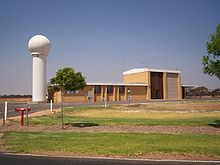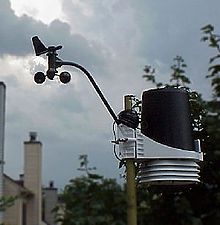- Weather station
-
A weather station is a facility, either on land or sea, with instruments and equipment for observing atmospheric conditions to provide information for weather forecasts and to study the weather and climate. The measurements taken include temperature, barometric pressure, humidity, wind speed, wind direction, and precipitation amounts. Wind measurements are taken as free of other obstructions as possible, while temperature and humidity measurements are kept free from direct solar radiation, or insolation. Manual observations are taken at least once daily, while automated observations are taken at least once an hour. Weather conditions out at sea are taken by ships and buoys, which measure slightly different meteorological quantities such as sea surface temperature, wave height, and wave period. Drifting weather buoys outnumber their moored versions by a significant amount.
Contents
Instruments
Typical weather stations have the following instruments:
- Thermometer for measuring air and sea surface temperature
- Barometer for measuring atmospheric pressure
- Hygrometer for measuring humidity.
- Anemometer for measuring wind speed
- Rain gauge for measuring liquid precipitation over a set period of time.
In addition, at certain Automated airport weather stations, additional instruments may be employed, including:
- Present Weather/Precipitation Identification Sensor for identifying falling precipitation
- Disdrometer for measuring drop size distribution
- Transmissometer for measuring visibility
- Ceiling projector for measuring cloud ceiling
More sophisticated stations may also measure the ultraviolet index, solar radiation, leaf wetness, soil moisture, soil temperature, water temperature in ponds, lakes, creeks, or rivers, and occasionally other data.
Exposure
Except for those instruments requiring direct exposure to the elements (anemometer, rain gauge), the instruments should be sheltered in a vented box, usually a Stevenson screen, to keep direct sunlight off the thermometer and wind off the hygrometer. The instrumentation may be specialized to allow for periodic recording otherwise significant manual labour is required for record keeping. Automatic transmission of data, in a format such as METAR, is also desirable as many weather station's data is required for weather forecasting.
Personal weather station
A personal weather station is a set of weather measuring instruments operated by a private individual, club, association, or even business (where obtaining and distributing weather data is not a part of the entity's business operation). The quality and number of instruments can vary widely, and placement of the instruments, so important to obtaining accurate, meaningful, and comparable data, can also be very variable.
Today's personal weather stations also typically involve a digital console that provides readouts of the data being collected. These consoles may interface to a personal computer where data can be displayed, stored, and uploaded to Web sites or data ingestion/distribution systems.
Personal weather stations may be operated solely for the enjoyment and education of the owner, but many personal weather station operators also share their data with others, either by manually compiling data and distributing it, or through use of the Internet or amateur radio. The Citizen Weather Observer Program (CWOP) is one such, and the data submitted through use of software, a personal computer, and internet connection (or amateur radio) are utilized by the National Weather Service when generating forecast models, and by many other entities as well. Each weather station submitting data to CWOP will also have an individual Web page that depicts the data submitted by that station. The Weather Underground Internet site is another popular destination for the submittal and sharing of data with others around the world. As with CWOP, each station submitting data to The Weather Underground has a unique Web page displaying their submitted data.
Dedicated ships
A weather ship was a ship stationed in the ocean as a platform for surface and upper air meteorological observations for use in weather forecasting. It was also meant to aid in search and rescue operations and to support transatlantic flights.[1][2] The establishment of weather ships proved to be so useful during World War II that the International Civil Aviation Organization (ICAO) established a global network of 13 weather ships in 1948.[1] Of the 12 left in operation in 1996, nine were located in the northern Atlantic ocean while three were located in the northern Pacific ocean. The agreement of the weather ships ended in 1990. Weather ship observations proved to be helpful in wind and wave studies, as they did not avoid weather systems like merchant ships tended to and were considered a valuable resource.[3] The last weather ship was MS Polarfront, known as weather station M ("Mike") at 66°N, 02°E, run by the Norwegian Meteorological Institute. MS Polarfront was removed from service January 1, 2010. Since the 1960s this role has been largely superseded by satellites, long range aircraft and weather buoys. Weather observations from ships continue from a fleet of voluntary merchant vessels in routine commercial operation.
Dedicated buoys
Weather buoys are instruments which collect weather and ocean data within the worlds oceans. Moored buoys have been in use since 1951,[4] while drifting buoys have been used since the late 1970s.[5] Moored buoys are connected with the ocean bottom using either chains, nylon, or buoyant polypropylene.[6] With the decline of the weather ship, they have taken a more primary role in measuring conditions over the open seas since the 1970s.[7] During the 1980s and 1990s, a network of buoys in the central and eastern tropical Pacific ocean helped study the El Niño-Southern Oscillation.[8] Moored weather buoys range from 1.5 metres (4.9 ft) to 12 metres (39 ft) in diameter,[6] while drifting buoys are smaller, with diameters of 30 centimetres (12 in) to 40 centimetres (16 in).[9] Drifting buoys are the dominant form of weather buoy in sheer number, with 1250 located worldwide.[5] Wind data from buoys has smaller error than that from ships.[10] There are differences in the values of sea surface temperature measurements between the two platforms as well, relating to the depth of the measurement and whether or not the water is heated by the ship which measures the quantity.[11]
Networks
A variety of land-based weather station networks have been set up globally. Some of these are basic to analyzing weather fronts and pressure systems, such as the synoptic observation network, while others are more regional in nature.
Global
- Citizen Weather Observer Program[12]
- Weather Underground Personal Weather Stations[13]
United States
- Arizona Meteorological Network (AZMET)[14]
- Central Pennsylvania Volunteer Weather Station Network[15]
- Florida Automated Weather Network (FAWN)[16]
- Georgia Environmental Monitoring Network (GAEMN)[17]
- Indiana Purdue Automated Agricultural Weather Station Network (PAAWS)[18]
- Iowa Environmental Mesonet (IEM)[19]
- MesoWest[20]
- Michigan Automated Weather Network (MAWN)[21]
- Missouri Weather Stations[22]
- National Weather Service Cooperative Observer Program[23]
- Oklahoma Mesonet[24]
- The Pacific Northwest Cooperative Agricultural Weather Network[25]
Southern Hemisphere
- Antarctic Automatic Weather Stations Project[26]
- Australia/Bureau of Meteorology AWS network.[27]
- Australia/Department of Agriculture and Food Western Australia[28]
- Australia/Lower Murray Water Automatic Weather Station Network[29]
See also
References
- ^ a b "Britain's First Weather Ship". Popular Mechanics: 136. June 1948. http://books.google.com/books?id=QtkDAAAAMBAJ&pg=PA136&lpg=PA136&dq=weather+ship+book#v=onepage&q=weather%20ship%20book&f=false. Retrieved 2011-01-18.
- ^ Malcolm Francis Willoughby. The U.S. Coast Guard in World War II. pp. 127–130. http://books.google.com/books?id=T5A9LCujs08C&pg=PA129&lpg=PA129&dq=weather+ship+book#v=onepage&q=weather%20ship%20book&f=false. Retrieved 2011-01-18.
- ^ Stanislaw R. Massel (1996). Ocean surface waves: their physics and prediction. World Scientific. pp. 369–371. ISBN 9789810221096. http://books.google.com/books?id=8sHp9ml7G6YC&pg=PA371&lpg=PA371&dq=weather+ship+book#v=onepage&q=weather%20ship%20book&f=false. Retrieved 2011-01-18.
- ^ G. L. Timpe and N. Van de Voorde (October 1995). "NOMAD buoys: an overview of forty years of use". OCEANS '95. MTS/IEEE. Challenges of Our Changing Global Environment. Conference Proceedings 1: 309–315. doi:10.1109/OCEANS.1995.526788.
- ^ a b National Aeronautics and Space Administration (2009-04-15). "Ocean Motion and Surface Currents". http://oceanmotion.org/html/gatheringdata/buoysanddrifers.htm. Retrieved 2011-01-28.
- ^ a b National Data Buoy Center (2008-02-04). "Moored Buoy Program". National Oceanic and Atmospheric Administration. http://www.ndbc.noaa.gov/mooredbuoy.shtml. Retrieved 2011-01-29.
- ^ National Research Council (U.S.). Ocean Science Committee, National Research Council (U.S.). Study Panel on Ocean Atmosphere Interaction (1974). The role of the ocean in predicting climate: a report of workshops conducted by Study Panel on Ocean Atmosphere Interaction under the auspices of the Ocean Science Committee of the Ocean Affairs Board, Commission on Natural Resources, National Research Council. National Academies. p. 40. http://books.google.com/books?id=2zQrAAAAYAAJ&pg=PA40&dq=weather+ship+network+book#v=onepage&q=weather%20ship%20network%20book&f=false. Retrieved 2011-01-18.
- ^ K. A. Browning, Robert J. Gurney (1999). Global energy and water cycles. Cambridge University Press. p. 62. ISBN 9780521560573. http://books.google.com/books?id=DO5K1NK_ZewC&pg=PA62&dq=1990+TOGA+ocean+buoy+network+Pacific+ocean+book#v=onepage&q&f=false. Retrieved 2011-01-09.
- ^ R. Lumpkin and M. Pazos (2010-06-08). "What's a Drifter?". The Global Drifter Program. http://www.aoml.noaa.gov/phod/dac/gdp_drifter.php. Retrieved 2011-01-29.
- ^ Bridget R. Thomas, Elizabeth C. Kent, and Val R. Swail (2005). "Methods to Homogenize Wind Speeds From Ships and Buoys". International Journal of Climatology (John Wiley & Sons, Ltd.) 25: 979–995. Bibcode 2005IJCli..25..979T. doi:10.1002/joc.1176. ftp://ftp.wmo.int/Documents/PublicWeb/amp/mmop/documents/JCOMM-TR/J-TR-13-Marine-Climatology/REV1/joc1176.pdf. Retrieved 2011-01-29.
- ^ William J. Emery, Richard E. Thomson (2001). Data analysis methods in physical oceanography. Gulf Professional Publishing. pp. 24–25. ISBN 9780444507570. http://books.google.com/books?id=A6ew-bJDIDIC&pg=PA24&dq=measurement+of+sea+surface+temperature+bucket+of+water+book#v=onepage&q=measurement%20of%20sea%20surface%20temperature%20bucket%20of%20water%20book&f=false. Retrieved 2011-01-09.
- ^ Russ Chadwick. Citizen Weather Observer Program. Retrieved on 2008-06-11.
- ^ Weather Underground. Personal Weather Station. Retrieved on 2008-06-11.
- ^ Arizona Meteorological Network. Retrieved on 2008-06-11.
- ^ Pennsylvania State Climatologist. Central Pennsylvania Volunteer Weather Station Network. Retrieved on 2008-06-11.
- ^ University of Florida. Florida Automated Weather Network. Retrieved on 2008-06-11.
- ^ University of Georgia. Georgia Environmental Monitoring Network. Retrieved on 2010-09-01.
- ^ NCAR.Indiana Purdue Automated Agricultural Weather Station Network (PAAWS). Retrieved on 2008-06-11.
- ^ Iowa State University Department of Agronomy. Iowa Environmental Mesonet. Retrieved on 2009-11-12.
- ^ University of Utah. MesoWest. Retrieved on 2008-06-11.
- ^ Michigan State University. Michigan Automated Weather Network (MAWN). Retrieved on 2008-12-01.
- ^ University of Missouri Agricultural Electronic Bulletin Board. Missouri Weather Stations. Retrieved on 2008-06-11.
- ^ National Weather Service. Cooperative Observer Program. Retrieved on 2008-06-11.
- ^ University of Oklahoma. Oklahoma Mesonet. Retrieved on 2008-06-11.
- ^ AgriMet: The Pacific Northwest Cooperative Agricultural Weather Network. Retrieved on 2008-06-05.
- ^ Automatic Weather Stations Project. Antarctic Automatic Weather Stations Project. Retrieved on 2008-06-11.
- ^ Bureau of Meteorology. Automatic Weather Stations for Agricultural and Other Applications. Retrieved on 2008-06-11.
- ^ Department of Agriculture and Food Western Australia. Department of Agriculture and Food Western Australia Weather Stations. Retrieved on 2008-06-11.
- ^ Lower Murray Water Resources. Lower Murray Water Automatic Weather Station Network. Retrieved on 2008-06-11.
External links
- Association of American Weather Observers
- Citizen Weather Observer Program
- CWOP Weather Station Siting, Performance, and Data Quality Guide
- Initial Guidance to Obtain Representative Meteorological Observations at Urban Sites, by Tim R. Oke
- International Weather Watchers Observer Handbook
- NWS Cooperative Observer Program
- NWS Observing Handbook No. 2: Cooperative Station Observations
Categories:- Meteorological instrumentation and equipment
- Meteorological stations
Wikimedia Foundation. 2010.




